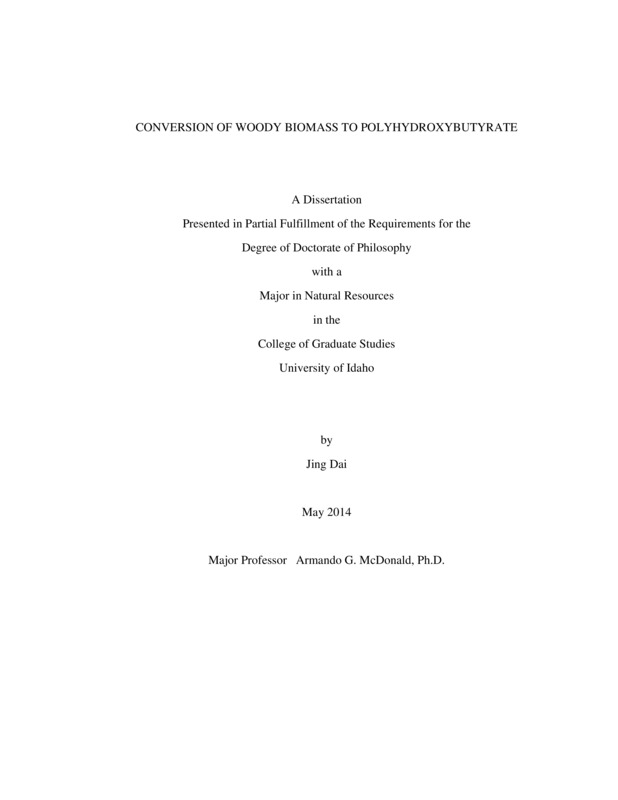Conversion of woody biomass to polyhydroxybutyrate
Dai, Jing. (2014). Conversion of woody biomass to polyhydroxybutyrate. Theses and Dissertations Collection, University of Idaho Library Digital Collections. https://www.lib.uidaho.edu/digital/etd/items/dai_idaho_0089e_10345.html
- Title:
- Conversion of woody biomass to polyhydroxybutyrate
- Author:
- Dai, Jing
- Date:
- 2014
- Keywords:
- enzymatic hydrolysis hot-water pretreatment hybrid poplar mixed microbial cultures polyhydroxybutyrate biosynthesis polyhydroxybutyrate characterization
- Program:
- Natural Resources
- Subject Category:
- Plastics; Polymer chemistry; Wood sciences
- Abstract:
-
This project focused on the conversion of wood to the bioplastic polyhydroxybutyrate (PHB) that was successfully achieved. The first step of the conversion of wood involved a hot-water pretreatment process followed by enzymatic hydrolysis to release the monosaccharides (hydrolysates) from the lignocellulosic structure. The process was optimized using a response surface methodology (RSM). This method was proved to be efficient to convert 95% of total carbohydrates into monosaccharides (sugars) which also generated limited amount of fermentation inhibitors such as acetic acid (<1.5 g/L), furfural (<0.1 g/L) and hydroxymethylfufural (HMF) (<0.1 g/L).
The bioconversion of wood hydrolysates to PHB was successfully performed using mixed microbial cultures (MMCs). Through the optimization of fed-batch experiments using a statistical design of experiments, several bioreactors could finally reach the steady states with reasonable PHB yields. The maximum PHB accumulated was 27% cell dry weight with a yield of 0.32 g/g (g PHB produced per g sugars consumed). Microbial community analysis was done at genus level, by next generation genomic sequencing, and the results showed that MMCs presented a community evolution in different bioreactors and during operational period. Several characterized genera belonged to Alphaproteobacteria and Betaproteobacteria classes such as Rhizobium, Sphingobium, Paracoccus, and Amaricoccus which have been characterized as PHA-storing microorganisms.
PHB Polymer characterization (chemical structure, PHB content modelling by FTIR, molecular weight, thermal and mechanical properties) had been evaluated for isolated PHB derived from MMC and compared with isolated pure culture PHB and a commercial PHB. Results showed that the properties of MMC PHB were similar to isolated pure culture and commercial PHB, which proved that MMC PHB was a good replacement for pure culture PHB.
- Description:
- doctoral, Ph.D., Natural Resources -- University of Idaho - College of Graduate Studies, 2014
- Major Professor:
- McDonald, Armando G
- Committee:
- Gorman, Thomas M; Coats, Erik R; Shook, Steven R
- Defense Date:
- 2014
- Identifier:
- Dai_idaho_0089E_10345
- Type:
- Text
- Format Original:
- Format:
- application/pdf
- Rights:
- In Copyright - Educational Use Permitted. For more information, please contact University of Idaho Library Special Collections and Archives Department at libspec@uidaho.edu.
- Standardized Rights:
- http://rightsstatements.org/vocab/InC-EDU/1.0/

